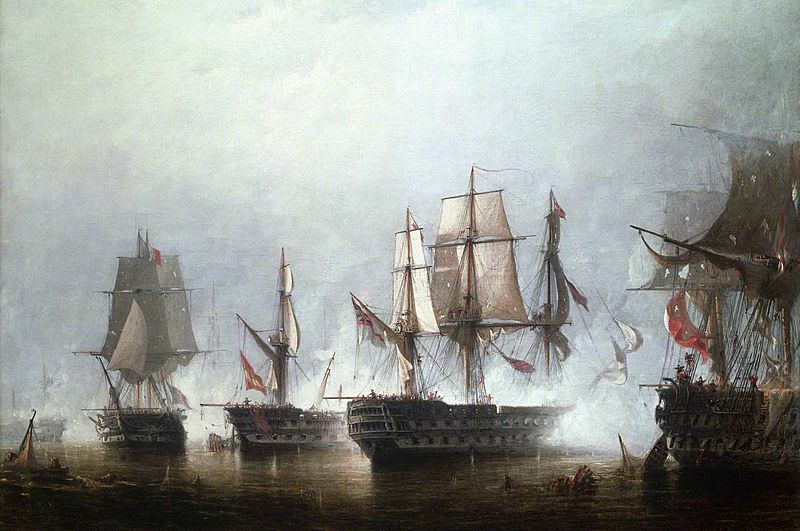Image: Richard Henry Nibbs (1816-1893) - The Battle of Trafalgar, 21 October 1805 - BHC0555 - Royal Museums Greenwich

Description: In the centre and right of centre of the painting is the British ship Colossus. Her guns are shown firing into the French Argonaute which is in the foreground to the right. Beyond and to the left of the 'Colossus' and partially masked by her is the stern of the Spanish Bahama whose colours are being struck. A union flag has been placed over her side just aft of her mizzen shrouds. Astern of her, and nearly bow on, is the Swiftsure an ex-British ship which had been captured by the French in 1801 and is now about to be recaptured. Across the foreground floats the wreckage of spars and sails. The painting was later turned into a lithograph by J. Needham. It is signed with a detailed inscription on the back. The good relations between Britain and the Ottoman Court following the Battle of the Nile were so eroded that by 1806 war was in the air. Strategically the Dardanelles was of great importance, as it commanded the approach to Constantinople from the Mediterranean. Although the passage of the strait was easily defended, in 1807 the English admiral Sir John Duckworth made his way past all the fortresses into the Sea of Marmora. When affairs in Constantinople required the presence of a naval force Duckworth was detached there with five ships. He was instructed to safeguard the British ambassador, Charles Arbuthnot. He was also to require Ottoman compliance with British demands, by anchoring close off the city. He was to open fire if he did not receive satisfaction within half an hour. Duckworth carried out his orders as far as he was able and forced the Dardanelles on 19 February 1807. He sailed through with seven ships of the line and some smaller vessels, and silenced the forts at Sestos and Abydos, destroying some Turkish ships. He ran the gauntlet of the Turkish batteries which included some medieval fixed bombards firing stone shot of up to 800lbs. Miraculously no serious damage was sustained, the casualties were six killed and 51 injured He anchored opposite Constantinople, threatening to bombard it. However without the appropriate troops a landing was pointless and he realized that the Turks were stalling him while strengthening their defences. Sir John failed to make the Turks accede to his demands although he recognised that the Dardanelles would be harder to re-pass. On 3 March he audaciously sailed back through the Dardanelles and sustaining heavier casualties than on his way in. https://www.rmg.co.uk/collections/objects/rmgc-object-12047 https://prints.rmg.co.uk/products/the-battle-of-trafalgar-21-october-1805-bhc0555
Title: The Battle of Trafalgar, 21 October 1805 title QS:P1476,en:"The Battle of Trafalgar, 21 October 1805 " label QS:Len,"The Battle of Trafalgar, 21 October 1805 "
Credit: Art UK
Author: Richard Henry Nibbs
Usage Terms: Public domain
License: Public domain
Attribution Required?: No
Image usage
The following 3 pages link to this image:

